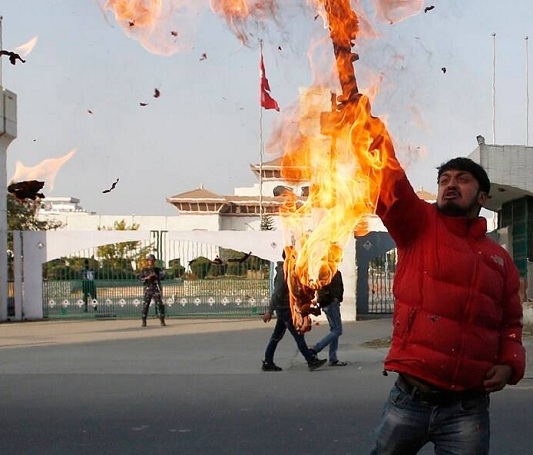Nepal Situation Unstable
| Date :20-Jul-2021 |

By BARUN DAS GUPTA :
Beijing had taken an active interest in keeping the two factions of the Nepal Communist Party together, so that the Government survived. But the bitterness between the Oli and Prachanda factions had reached a stage where no compromise or patch-up formula could work. The party broke up.
THE political kaleidoscope has turned again in Nepal, throwing up yet another Government. The Nepal Supreme Court on Monday restored Parliament which was dissolved by President Bidya Devi Bhandari on May 21, after Prime Minister K P Sharma Oli lost majority in the House. The President announced that elections to the House of Representatives would be held on November 12 and 19. Oli continued to be the Prime Minister because no other party or an alliance of parties could form an alternative Government. On Monday, the apex court not only restored Parliament but ordered President Bhandari to appoint Nepali Congress President Sher Bahadur Deuba as the new Prime Minister. This has upset Oli’s plan to continue as PM till November this year. The five-member Constitutional Bench of the Supreme Court has also ordered summoning of the House by July 18.
As there is no question of seeking a trust vote, Deuba is expected to continue as PM till November. Political instability in Nepal has persisted because the three principal parties – the two factions of the now defunct Nepal Communist Party and the Nepali Congress – have their voters fiercely loyal to their respective parties. In the present House of Representatives (Lower House), the Oli faction of the now dissolved Nepal Communist Party has 121 members, the Prachanda faction has 49 members and the Nepali Congress has 63 members. There is a bunch of smaller parties, each having one or two representatives in the House and do not add up to a significant number to sway the voting in the House this way or that. In any fresh election, the parliamentary strength of the three parties is expected to remain more or less the same.
This means that no stable Government can be formed unless the Prachanda faction of the Communist Party agrees to an alliance with the Nepal Congress. Then there is the China factor. Beijing had taken an active interest in keeping the two factions of the Nepal Communist Party together, so that the Government survived. But the bitterness between the Oli and Prachanda factions had reached a stage where no compromise or patch-up formula could work. The party broke up. If Nepali Congress is able to win the next elections and form a Government with Prachanda, then China’s hold on Nepal is expected to be considerably reduced and relations with India are likely to improve. Unlike China, India has scrupulously kept herself aloof from the domestic politics of Nepal. Nepal is also being wary of the “debt trap” of China in which it has been caught. If India were to have a greater participation in Nepal’s economic development, especially in infrastructure building, it could have neutralised Beijing’s influence on Nepal. But with a corona-devastated economy, it is doubtful if India could, at the moment, come to the economic aid of Nepal to a great extent. China has made huge investments in Nepal mainly for infrastructure projects (especially hydro-power development) and on the construction of the railway line connecting Kathmandu with Tibet’s capital Lhasa. Recently, Leela Mani Paudial, a former ambassador to China, emphasised the importance of the Belt and Road Initiative (BRI) in Nepal’s foreign policy. He pointed out that “there is a huge gap in Nepal’s development financing that BRI can supplement the other sources of financing.”
He also made it known that Nepal was opposed to the “Indo-Pacific Strategy,” which means the emerging military cooperation between the US, Japan, Australia and India or “Quad” which is meant to contain the Chinese challenge in the Indian and Pacific Oceans. All these may change under Deuba. The present rulers of Nepal seem to be either unaware of or are under-estimating the danger of Nepal falling into China’s debt trap like Sri Lanka, Bangladesh, Pakistan, etc. These countries were lured by China’s offer of liberal financial “assistance” for economic development. It is only when the problem of repayment of the principal along with the interest arose that they found they had been caught in a debt-trap. China has ruthlessly used the “debt diplomacy” to influence the foreign and domestic policies of these countries. A Nepali Congress Government, supported by Prachanda’s Communist Party of Nepal (Maoist Centre) may move away from Oli’s pro-Chinese foreign policy and opt for building closer and stronger ties with India. The relationship between the leaders of the Indian National Congress and the Nepali Congress has always been cordial since the formation of the Nepali Congress in April, 1950. Those were troubled times. The people were trying to overthrow the tyrannical Rana Sahi.
They enjoyed the full sympathy and support of the leaders of the Indian National Congress and the Socialist Party. Jawaharlal Nehru never concealed his support for the democratic movement in Nepal. Nor did Jayaprakash Narayan. The history of that period was documented by a Socialist Party leader of Bengal in his book Unishsho Panchasher Nepal (Nepal of 1950). As disillusionment spreads about the nature of Chinese assistance among the debtor countries of Asia, India should take full diplomatic advantage of the situation and try to win friends and influence the people of these countries. Together, India and Nepal can be a bulwark against Chinese expansionism. A stable Government in Nepal will help strengthen Indo-Nepal friendship to mutual advantage. (IPA)